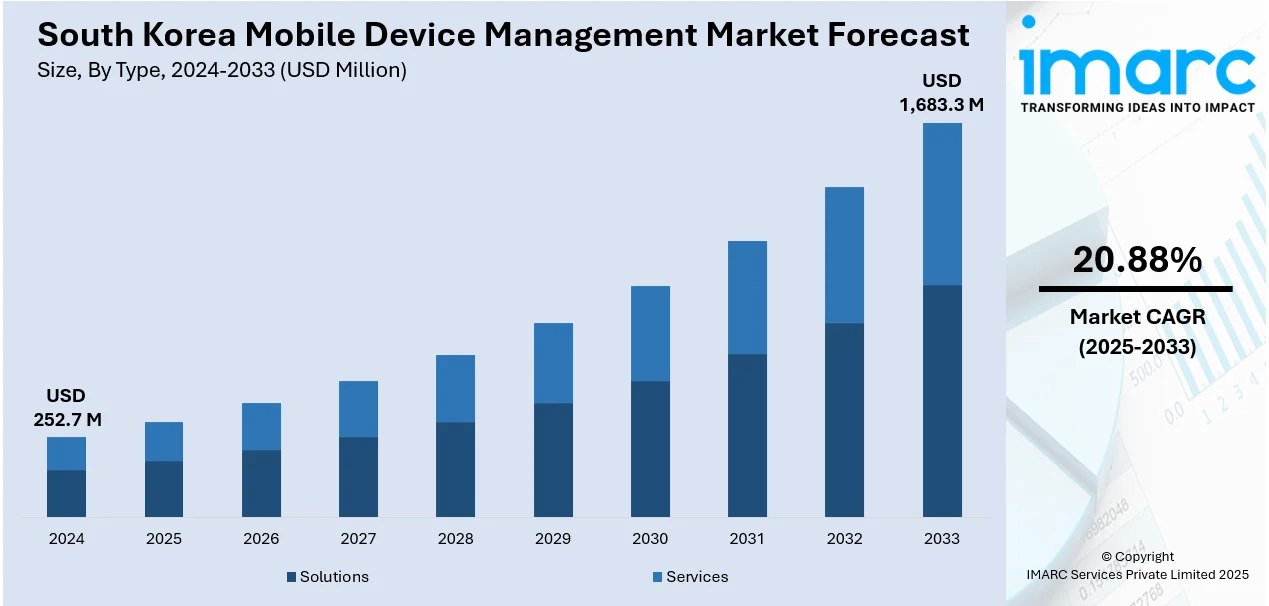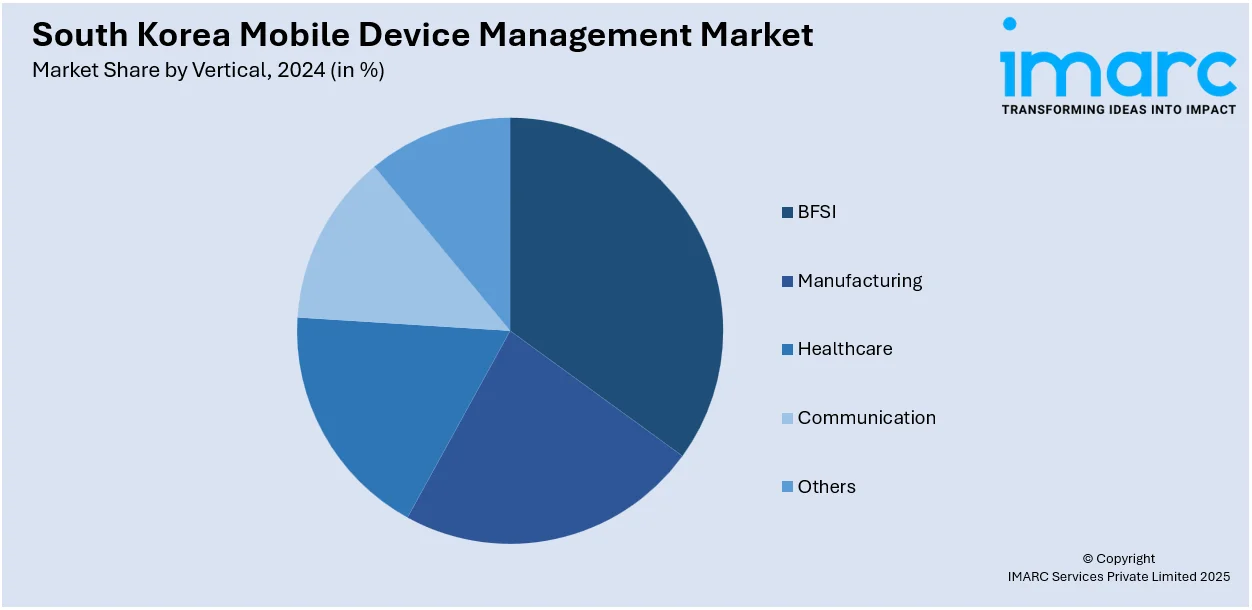
South Korea Mobile Device Management Market Size, Share, Trends and Forecast by Type, Deployment Type, Organization Size, Vertical, and Region, 2025-2033
South Korea Mobile Device Management Market Overview:
The South Korea mobile device management market size reached USD 252.7 Million in 2024. The market is projected to reach USD 1,683.3 Million by 2033, exhibiting a growth rate (CAGR) of 20.88% during 2025-2033. The market is expanding due to increased adoption of mobile security tools across enterprises and rising demand for remote device control. Additionally, growing use of BYOD policies and cloud-based deployment options continues to support South Korea mobile device management market share among public and private sector organizations.
|
Report Attribute
|
Key Statistics
|
|---|---|
|
Base Year
|
2024
|
|
Forecast Years
|
2025-2033
|
|
Historical Years
|
2019-2024
|
| Market Size in 2024 | USD 252.7 Million |
| Market Forecast in 2033 | USD 1,683.3 Million |
| Market Growth Rate 2025-2033 | 20.88% |
South Korea Mobile Device Management Market Trends:
Rising Demand for Enterprise Control
The South Korea mobile device management market growth is being influenced by the rising adoption of mobile devices in workplaces across sectors like healthcare, finance, education, and manufacturing. Businesses are placing more importance on protecting corporate data accessed through smartphones and tablets. With the rise in hybrid and remote work environments, enterprises are deploying MDM solutions to remotely manage, monitor, and secure employee devices. These tools help enforce security policies, limit app usage, and prevent unauthorized data sharing. The increased frequency of cyberattacks and data breaches has added urgency to implement strict mobile security measures. In recent months, small and medium-sized businesses have also started to follow larger enterprises in adopting MDM tools to ensure policy compliance and reduce IT workload. Solutions that offer centralized dashboards, real-time alerts, and analytics are in high demand. Companies are looking for tools that integrate smoothly with existing systems and allow easy onboarding of new devices. The availability of cloud-based MDM platforms with flexible pricing models is another reason for the steady rise in adoption. Enterprises prefer services that support cross-platform compatibility and automated updates. Unified endpoint management is becoming popular, with firms choosing platforms that allow control of smartphones, tablets, laptops, and desktops from one place.

To get more information on this market, Request Sample
Growing Security and OS Diversity Needs
Security threats such as phishing attacks, malware, and lost or stolen devices are pushing South Korean organizations to strengthen mobile management strategies. With more employees using personal devices for work under BYOD policies, ensuring data protection has become more complex. Companies are adopting containerization, application control, and remote wipe features to separate personal and business data while maintaining user privacy. These tools make it easier to enforce corporate policies without disrupting personal usage. The wide variety of mobile operating systems and devices being used—especially Android and iOS—has made compatibility a major concern. Businesses are prioritizing solutions that can work seamlessly across different platforms, provide consistent policy enforcement, and detect risky behavior automatically. To address these demands, MDM vendors are offering enhanced support for multi-OS environments along with AI-driven compliance tools that can flag unauthorized apps or outdated software. Recent developments include telecom providers bundling MDM services with business mobile plans, allowing companies to get device management as part of their standard offerings. Hardware manufacturers are also partnering with software developers to provide pre-configured devices with built-in management features, simplifying deployment and reducing setup time. These trends are making it easier for South Korean firms to control security risks while managing a growing fleet of diverse devices.
South Korea Mobile Device Management Market Segmentation:
IMARC Group provides an analysis of the key trends in each segment of the market, along with forecasts at the country and regional level for 2025-2033. Our report has categorized the market based on type, deployment type, organization size, and vertical.
Type Insights:
- Solutions
- Services
The report has provided a detailed breakup and analysis of the market based on the type. This includes solutions and services.
Deployment Type Insights:
- On-premises
- Cloud-based
A detailed breakup and analysis of the market based on the deployment type have also been provided in the report. This includes on-premises and cloud-based.
Organization Size Insights:
- Large Enterprises
- Small and Medium-Sized Enterprises
The report has provided a detailed breakup and analysis of the market based on the organization size. This includes large enterprises and small and medium-sized enterprises.
Vertical Insights:

- BFSI
- Manufacturing
- Healthcare
- Communication
- Others
A detailed breakup and analysis of the market based on the vertical have also been provided in the report. This includes BFSI, manufacturing, healthcare, communication, and others.
Regional Insights:
- Seoul Capital Area
- Yeongnam (Southeastern Region)
- Honam (Southwestern Region)
- Hoseo (Central Region)
- Others
The report has also provided a comprehensive analysis of all the major regional markets, which include Seoul Capital Area, Yeongnam (Southeastern Region), Honam (Southwestern Region), Hoseo (Central Region), and others.
Competitive Landscape:
The market research report has also provided a comprehensive analysis of the competitive landscape. Competitive analysis such as market structure, key player positioning, top winning strategies, competitive dashboard, and company evaluation quadrant has been covered in the report. Also, detailed profiles of all major companies have been provided.
South Korea Mobile Device Management Market News:
- October 2024: Samsung and KT began deploying a Private 5G network for the Republic of Korea Navy, integrating AI-driven connectivity and digital twin systems. This initiative advanced Mobile Device Management by enabling secure, real-time control over military assets, enhancing operational efficiency and defense communication capabilities.
- February 2024: Stage X announced a USD 462 Million investment to deploy 6,000 28 GHz 5G base stations across South Korea. By integrating AI for network management and enabling 28 GHz device support, it strengthened Mobile Device Management capabilities and enhanced nationwide connectivity infrastructure for smart devices.
South Korea Mobile Device Management Market Report Coverage:
| Report Features | Details |
|---|---|
| Base Year of the Analysis | 2024 |
| Historical Period | 2019-2024 |
| Forecast Period | 2025-2033 |
| Units | Million USD |
| Scope of the Report |
Exploration of Historical Trends and Market Outlook, Industry Catalysts and Challenges, Segment-Wise Historical and Future Market Assessment:
|
| Types Covered | Solutions, Services |
| Deployment Types Covered | On-premises, Cloud-based |
| Organization Sizes Covered | Large Enterprises, Small and Medium-Sized Enterprises |
| Verticals Covered | BFSI, Manufacturing, Healthcare, Communication, Others |
| Regions Covered | Seoul Capital Area, Yeongnam (Southeastern Region), Honam (Southwestern Region), Hoseo (Central Region), Others |
| Customization Scope | 10% Free Customization |
| Post-Sale Analyst Support | 10-12 Weeks |
| Delivery Format | PDF and Excel through Email (We can also provide the editable version of the report in PPT/Word format on special request) |
Key Questions Answered in This Report:
- How has the South Korea mobile device management market performed so far and how will it perform in the coming years?
- What is the breakup of the South Korea mobile device management market on the basis of type?
- What is the breakup of the South Korea mobile device management market on the basis of deployment type?
- What is the breakup of the South Korea mobile device management market on the basis of organization size?
- What is the breakup of the South Korea mobile device management market on the basis of vertical?
- What is the breakup of the South Korea mobile device management market on the basis of region?
- What are the various stages in the value chain of the South Korea mobile device management market?
- What are the key driving factors and challenges in the South Korea mobile device management market?
- What is the structure of the South Korea mobile device management market and who are the key players?
- What is the degree of competition in the South Korea mobile device management market?
Key Benefits for Stakeholders:
- IMARC’s industry report offers a comprehensive quantitative analysis of various market segments, historical and current market trends, market forecasts, and dynamics of the South Korea mobile device management market from 2019-2033.
- The research report provides the latest information on the market drivers, challenges, and opportunities in the South Korea mobile device management market.
- Porter's Five Forces analysis assists stakeholders in assessing the impact of new entrants, competitive rivalry, supplier power, buyer power, and the threat of substitution. It helps stakeholders to analyze the level of competition within the South Korea mobile device management industry and its attractiveness.
- Competitive landscape allows stakeholders to understand their competitive learning type and provides an insight into the current positions of key players in the market.
Need more help?
- Speak to our experienced analysts for insights on the current market scenarios.
- Include additional segments and countries to customize the report as per your requirement.
- Gain an unparalleled competitive advantage in your domain by understanding how to utilize the report and positively impacting your operations and revenue.
- For further assistance, please connect with our analysts.
 Request Customization
Request Customization
 Speak to an Analyst
Speak to an Analyst
 Request Brochure
Request Brochure
 Inquire Before Buying
Inquire Before Buying




.webp)




.webp)












